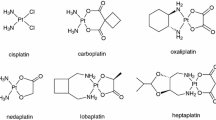Abstract
Purpose
Doxorubicin (1) is commonly used in the treatment of a wide range of cancers. Some N-acylhydrazones of 1 were previously found to have an improved tumour and organ selectivity. In order to clarify the molecular basis for this effect, the cellular uptake into various cancer cells and the localisation in PtK2 potoroo kidney cells of 1 and its N-acylhydrazones derived from heptadecanoic acid (2) and 11-(menthoxycarbonyl)undecanoic acid (3) were studied drawing on their intrinsic fluorescence.
Methods
The uptake of compounds 1–3 into human cells of HL-60 leukaemia, 518A2 melanoma, HT-29 colon, and resistant KB-V1/Vbl and MCF-7/Topo breast carcinomas was determined fluorometrically from their residual amounts in the supernatant. Their time-dependent accumulation in PtK2 potoroo kidney cells was visualised by fluorescence microscopy.
Results
The uptake, though not the cytotoxicity, of 2 in multi-drug resistant MCF-7/Topo breast cancer cells was conspicuously greater than that of 1 and 3, probably due to an attractive lipophilic interaction with the lipid-rich membranes of these cells. In non-malignant PtK2 cells, both 1 and 3 accumulated initially in the nuclei. Upon prolonged incubation, their fluorescent metabolites were visualised in lysosomes neighbouring the nuclei. In contrast, conjugate 2 was not observed in the nuclei at any time. After 2 h, it had accumulated in vesicles scattered all over the cells, and upon prolonged incubation, its fluorescent metabolites were concentrated in the cellular membrane.
Conclusions
Long unbranched fatty acyl residues when attached to doxorubicin via a hydrazone can act as lipophilic membrane anchors. This allows an increased uptake of such derivatives into lipid-rich membranes especially of multi-drug resistant cancer cells, a retarded release from there into the cytosol and the eventual storage of their metabolites again in the cell membrane rather than in lysosomes.





Similar content being viewed by others
References
Robert J (1998) Anthracyclines. In: Grochow LB, Ames MM (eds) A clinician′s guide to chemotherapy, pharmcokinetics and pharmacodynamics. Williams and Wilkins, Baltimore, pp 93–173
Cragg GM, Grothaus PG, Newman DJ (2009) Impact of natural products on developing new anti-cancer agents. Chem Rev 109:3012–3043
Colucci MA, Moody CJ, Couch GD (2008) Natural and synthetic quinones and their reduction by the quinone reductase enzyme NQO1: from synthetic organic chemistry to compounds with anticancer potential. Org Biomol Chem 6:637–656
Bolton JL, Trush MA, Penning TM, Dryhurst G, Monks TJ (2000) Role of quinones in toxicology. Chem Res Toxicol 13:135–160
Minotti G, Menna P, Salvatorelli E, Cairo G, Gianni L (2004) Anthracyclines: molecular advances and pharmacologic developments in antitumor activity and cardiotoxicity. Pharmacol Rev 56:185–229
Gewirtz DA (1999) A critical evaluation of the mechanisms of action proposed for the antitumor effects of the anthracycline antibiotics adriamycin and daunorubicin. Biochem Pharmacol 57:727–741
Effenberger K, Breyer S, Schobert R (2010) Modulation of doxorubicin activity in cancer cells by conjugation with fatty acyl and terpenyl hydrazones. Eur J Med Chem 45:1947–1954
Effenberger K, Breyer S, Ocker M, Schobert R (2010) New doxorubicin N-acyl hydrazones with improved efficacy and cell line specificity show modes of action different from the parent drug. Int J Clin Pharmacol Ther 48:485–486
Noël G, Peterson C, Trouet A, Tulkens R (1978) Uptake and subcellular localization of daunorubicin and adriamycin in cultured fibroblasts. Eur J Cancer 14:363–368
Hurwitz SJ, Terashima M, Mizunuma N, Slapka CA (1997) Vesicular anthracycline accumulation in doxorubicin-selected U-937 cells: participation of lysosomes. Blood 89:3745–3754
Pietrzak M, Wieczorek Z, Stachelska A, Darzynkiewicz Z (2003) Interactions of chlorophyllin with acridine orange, quinacrine mustard and doxorubicin analyzed by light absorption and fluorescence spectroscopy. Biophys Chem 104:305–313
Szulawska A, Gniazdowski M, Czyz M (2005) Sequence specificity of formaldehyde-mediated covalent binding of anthracycline derivatives to DNA. Biochem Pharmacol 69:7–18
Karukstis KK, Thompson EHZ, Whiles JA, Rosenfeld RJ (1998) Deciphering the fluorescence signature of daunomycin and doxorubicin. Biophys Chem 73:249–263
Du H, Fuh RA, Li J, Corkan A, Lindsey JS (1998) PhotochemCAD: A computer-aided design and research tool in photochemistry. Photochem Photobiol 68:141–142
Munnier E, Tewes F, Cohen-Jonathan S, Linassier C, Douziech-Eyrolles L, Marchais H, Soucé M, Hervé K, Dubois P, Chourpa I (2007) On the interaction of doxorubicin with oleate ions: fluorescence spectroscopy and liquid-liquid extraction study. Chem Pharm Bull 55:1006–1010
Ramu A, Glaubiger D, Magrath IT, Joshi A (1983) Plasma membrane lipid structural order in doxorubicin-sensitive and resistant P388 cells. Cancer Res 43:5533–5537
Peetla C, Bhave R, Vijayaraghavalu S, Stine A, Kooijman E, Labhasetwar V (2010) Drug resistance in breast cancer cells: biophysical characterization of and doxorubicin interactions with membrane lipids. Mol Pharm 7(6):2334–2348
Lu P, Liu R, Sharom FJ (2001) Drug transport by reconstituted P-glycoprotein in proteoliposomes. Effect of substrates and modulators, and dependence on bilayer phase state. Eur J Biochem 268:1687–1697
Goormaghtigh E, Chatelain P, Caspers J, Ruysschaert JM (1980) Evidence of a specific complex between adriamycin and negatively charged phospholipids. Biochim Biophys Acta 597:1–14
Jensen CG, Wilson WR, Bleumink AR (1985) Effects of amsacrine and other DNA-intercalating drugs on nuclear and nucleolar structure in cultured V79 Chinese hamster cells and PtK2 rat kangaroo cells. Cancer Res 45:717–725
Acknowledgments
We thank the Deutsche Forschungsgemeinschaft for financial support (grant Scho 402/8-3) and Ribosepharm GmbH (Germany) for a free batch of doxorubicin.
Conflicts of interest
None.
Author information
Authors and Affiliations
Corresponding author
Rights and permissions
About this article
Cite this article
Effenberger-Neidnicht, K., Breyer, S., Mahal, K. et al. Modification of uptake and subcellular distribution of doxorubicin by N-acylhydrazone residues as visualised by intrinsic fluorescence. Cancer Chemother Pharmacol 69, 85–90 (2012). https://doi.org/10.1007/s00280-011-1675-z
Received:
Accepted:
Published:
Issue Date:
DOI: https://doi.org/10.1007/s00280-011-1675-z




